Almost as satisfying to say as it is to eat, this 17th-century dessert takes its name from the dry white wines of Sillery in the Champagne region of France, and from the Elizabethan slang for fizz, neatly describing its origins as a bubbly alcoholic milkshake. It remained popular – in a surprisingly wide variety of forms, from refreshing drink to solid cream – until the 19th century, and was revived in the postwar period by Elizabeth David, who saw its “pristine charm” as the perfect antidote to the “deep freezers… dehydrators and… emulsifiers” of what she termed “the Chemical Age”.
The Guardian’s product and service reviews are independent and are in no way influenced by any advertiser or commercial initiative. We will earn a commission from the retailer if you buy something through an affiliate link. Learn more.
Once again, the syllabub reared its foamy head on top of trifles and piles of soft summer fruit, beloved of everyone from Mary Berry to Nigel Slater, yet from all the options out there, modern recipes rarely stray from the thick, whipped “everlasting syllabub”. A boozy fool is all very well, of course, but are we missing out on a pleasure that’s stood the test of time?
Whipped, poured or curd?
In essence, a syllabub is a mix of dairy and alcohol. When the two meet, the acid in the booze, often enhanced with the judicious addition of lemon juice, causes the milk or cream to separate into creamy curds and sweet, tangy whey. However, simply pouring the milk into the alcohol, as recommended in Dorothy Hartley’s Food in England, results in a rather off-putting cottage cheese-like curd that the testers aren’t keen on, though they’re more than happy to drink the port beneath.
Many writers repeat the idea that originally, syllabubs were made by milking a cow directly into a bowl of booze – Gary Rhodes claims that Charles II kept cows in St James’s Park in case he fancied one while out riding. Though recipes certainly exist for such a concoction, food historian Ivan Day discovered that it “produces a result that differs radically from 20th-century expectations of what a syllabub should be. Although a bubbly froth initially forms on the top of the liquid, this quickly subsides and the mixture separates into a creamy whey below a floating mass of clotted, stringy curd, of a kind more likely to grace a baby’s bib than a regal banqueting table. Unless your syllabub cow is extremely well groomed, the congealing milk will also be garnished here and there with cow hairs and the odd speck of bovine dandruff, a most unappetising prospect, at least to our modern eyes.”
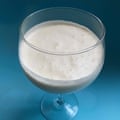
A similar, but rather cleaner, effect can be achieved by pouring the dairy from a great height into the booze, as recommended by several recipes, including that from Richard Briggs’ 1794 edition of The English Art of Cookery, which proves surprisingly effective once I read Day’s cautionary note that this method works only with cream, rather than milk. The first version is thin and lumpy, the second thick and pleasingly smooth, with a lacy top – much better than the “jumbled” variety that, after 10 minutes’ vigorous shaking, produces something more like a slightly grainy yoghurt. Both are fun for the historically minded, but I’d recommend a whisk for the real thing.
Regula Ysewijn recommends using a food mixer for the syllabub in her book Pride and Pudding, but it does give very thick, rich results – reluctantly, I must agree with Lindsey Bareham and Simon Hopkinson’s claim in The Prawn Cocktail Years that you’ll do better with a wire balloon whisk – principally, I think, because it’s far easier to over-whisk with electric beaters.
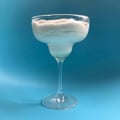
Mrs Beeton’s “No 2” recipe for syllabub, as collected in The Bloomsbury Cookbook, skims off the foam from the top of beaten cream and gradually builds it into a light, foamy mousse, but that takes an age to make. If you are tempted, disregard the instructions for whipping cream: it thickens rather than froths, as I found to my cost during my first attempt. Single cream, and patience, is what you need.
The booze
Having established a definite preference for the whisked variety, we may turn our attention to the ingredients, starting with the base alcohol (note that non-alcoholic syllabubs can be made with fruit juice, so if you don’t drink, all is not lost). A 1658 recipe claims that “syder” makes the best syllabub, but I’d disagree; like ale, it’s too weak for the task (though if anyone would like to try with the super-strength stuff, I’d be interested to know the results). Port, as recommended by Hartley, gives a pleasing, fruity flavour, but an unpleasant colour. Pudding wine, sherry and madeira all work well, but Ysewijn’s riesling provides the perfect balance of sweetness and acidity. Both, of course, can be bolstered with sugar and lemon juice, if you’d prefer to use a dry white wine, but you need only a quarter of a bottle, and the rest makes a very pleasing accompaniment.
A shot of brandy adds extra kick, but this is strictly optional: leave it out if you prefer. If you want a real syllabub, however, don’t be tempted to cut back on the wine: modern recipes tend to use a smaller proportion of alcohol to cream to stop the mixture separating, but this mix of feather-light cream and cool, tangy liquid is one of the things that distinguishes syllabub from similar desserts, so such puritanical impulses seem counterintuitive.
The dairy
The whipped syllabub method rules out milk and single cream, but double and extra-thick cream feel heavy: syllabub ought to be a lighter dessert than its cousin the fool, so whipping cream feels like a good compromise.
A throwaway note in Day’s manuscript alerts me to the possibility of strengthening the bubbles with egg white, though I’m unable to track down the original 1604 recipe to which he refers, so I have to improvise from a similar 19th-century American version. It does indeed give the mixture a lighter, foamier quality that seems in keeping with the original spirit of the dish – optional, but recommended.
The flavourings
Lemon and sugar are a must – you can infuse the wine with lemon zest overnight if you prefer a perfectly smooth consistency, but grated zest gives more instant gratification. Though the traditional caster sugar gives very serviceable results, my testers prefer the honey in Jane Grigson’s St Valentine’s syllabub, which also proves much easier to stir into the wine.
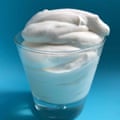
Beeton adds almond essence to her mixture, which is slightly cloying for our tastes, but proof that just about any flavour that pairs well with lemon and dairy should work here, from rosemary to rosewater. Then again, it’s pretty delicious as it is.
The perfect syllabub
Prep 5 min
Cook 20-25 min
Set 2-3 hr
Serves 4-6
200ml medium dry riesling
5 tbsp honey or caster sugar
1 unwaxed lemon, zested and juiced
3 tbsp brandy
300ml whipping cream
3 egg whites
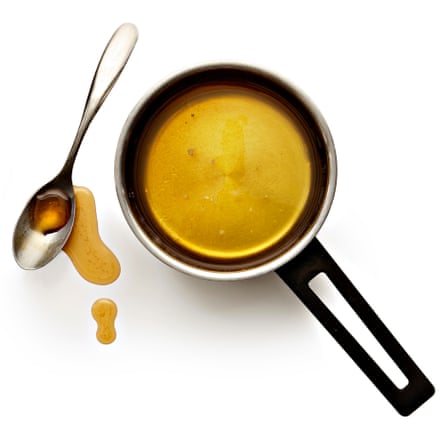
Warm the wine and stir in the honey until it has just dissolved. Finely grate in the lemon zest and leave to cool completely, then stir in the brandy and lemon juice.
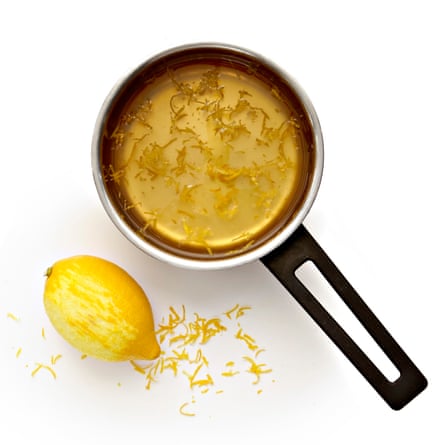
Tip the boozy mixture into a large bowl and slowly pour in the cream, whisking furiously, until it thickens to very soft peaks. Taste and add more of any of the ingredients as necessary.
In a clean bowl, whisk the egg whites to soft peaks, then fold gently through the cream mixture. Divide between glasses and chill for two to three hours, until it separates, or eat immediately if you prefer. It will keep a day or two in the fridge.
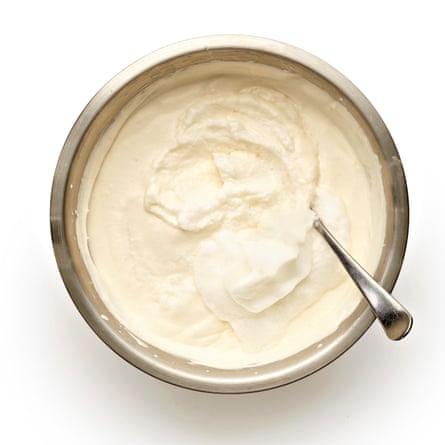
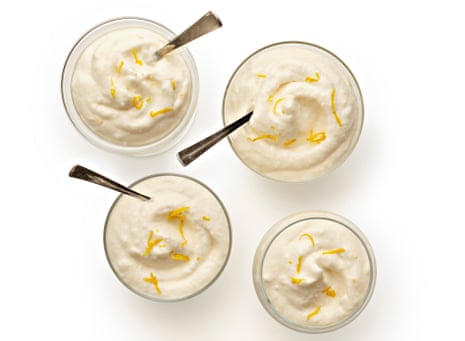
Comments (…)
Sign in or create your Guardian account to join the discussion